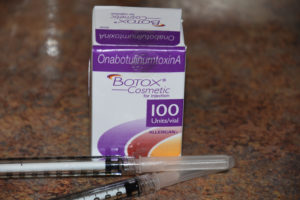
Unlike injectable fillers, the effects of Botox are not seen immediately. It takes several days for Botox to begin to ‘kick-in’and a full week for its maximal muscle-weakening effects to be seen. Clinical studies show that the average length of time that Botox works is between 100 to 130 days. (three to four months)
2. What is the difference between Botox and Dysport injections?
Botox was FDA approved for cosmetic use in 2002 and was the only injectable facial wrinkle reducer until recently. In the summer of 2009, Dysport became available as a competitive drug to Botox by a different manufacturer. It s a botulinum toxin with a slightly different molecular structure . While Dysport was released with much hype about its potential for lasting longer and being less expensive, my experience in my Indianapolis plastic surgery practice shows that much about it is comparable to Botox. If Dysport has any advantages over Botox, they are not yet apparent.
3. Will my face be frozen afterwards? Will I look unnatural?
A common patient concern and misconception about Botox is that one’s face will look unnatural afterwards…and be like some Hollywood faces. While this can certainly be achieved with Botox, it takes a lot of injections (high doses) and cost to create this unnatural look. And this is usually beyond the budget and desires of most patients. Judicious use of Botox in a few select facial areas produces a relaxed and natural facial look. Botox is primarily used to reduce furrowing betweens the eyebrows, lessen horizontal forehead wrinkles, and make wrinkles around the eyes less noticeable.
4. Does the regular use of Botox keep my wrinkles from getting deeper and keep me looking young?
Because Botox temporarily reduces wrinkling caused by continuous facial muscle activity, its regular use has long-term anti-aging facial benefits. Regular Botox use over years does result in less facial wrinkles because the cause of them has been reduced. I have seen this particularly illustrated in a set of identical twins where one has had Botox for over seven years and the other has not. The amount of facial wrinkles is significantly reduced in the Botox user.
5. Are Botox treatments the same no matter where I go?
In theory, the results of Botox injections should be the same no matter where you go. But there are a variety of factors that affect how well Botox works and what results are obtained. Injector experience, how Botox is prepared, where on the face injections are given, and how many units are administered all affect what results are seen.
6. Can one become immune to the effects of Botox?
Developing a resistance to a drug is always possible. Most patients never develop a tolerance or an immunity, but reported cases do exist. A minority of treated patients will develop a perception that Botox isn’t working as well as it used to. Whether this is because one has become accustomed to the results or whether it really is less effective is not clear. In these cases, one may try Dysport instead which has a slightly different formulation to which the body may be more susceptible.
7. What other cosmetic and medical conditions is Botox useful?
Botox has been around for over twenty years and has a variety of approved uses. Most of these are for muscular conditions such as spasms in cases of paralysis and for strabismus. (continuous eye muscle twitching) Botox has been approved during this past decade for hyperhidrosis (excessive sweating) of the armpits, hands, and feet. Encouraging results are being seen in off-label applications of the face such as in the treatment of certain migraine headaches and TMJ and jaw muscle disorders.
Dr. Barry Eppley
Indianapolis, Indiana


